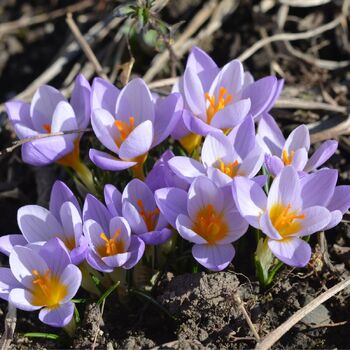
How to Grow Crocus Corms
Grow Guide #2921
Family: Iridaceae
Binomial name: Crocus sp.
Life Cycle: Perennial
This 'How to Grow' guide details everything a home gardener needs to know to plant, grow and care for Crocus (Crocus sp.).
When to Plant Crocus Corms
Use the table below to identify the best time of year to plant crocus corms in your climate. Crocus requires a climate with cold winters (with frost) to produce flowers; it is unsuitable for subtropical and tropical climates.
| JAN | FEB | MAR | APR | MAY | JUN | JUL | AUG | SEP | OCT | NOV | DEC | |
|---|---|---|---|---|---|---|---|---|---|---|---|---|
| Cool | ||||||||||||
| Temperate | ||||||||||||
| Sub-Tropical | ||||||||||||
| Tropical | ||||||||||||
| Arid |
Preparation
Crocus plants are best grown in full sun or part shade. Choose a location that will receive at least 3 hours of full sun each day.
Crocus plants need a loose, well drained soil enriched with organic matter. Prepare soil by weeding it thoroughly, digging it over to at least a spade’s depth to loosen the soil, and adding aged animal manure or compost. Organic matter can be dug into heavy soil to lighten it so roots can grow freely. Keep the area free of weeds until planting. Learn more about preparing soil for planting here.
Crocus plants can be grown in containers. If possible choose a variety that’s recommended for container growing. Use a good quality potting mix and make sure your container is large enough for mature plants; a minimum of 10 litres is recommended for crocus. During the growing season, keep in mind that container grown plants may need additional fertiliser to encourage healthy growth.
How to Plant Crocus Corms
Crocus corms should be planted directly in their final position in the garden or a container.
- Plant individual corms 5-10cm apart and 7-10cm deep with the pointed tip facing upwards.
- Cover with soil and water in well.
- Keep soil moist but not wet until shoots emerge.
How to Grow Crocus
Crocus plants may need watering during the growing season. Water when the soil is dry about 5cm below the surface (test this by scratching away a little soil with your finger). Water deeply in the early morning or late afternoon. Avoid watering the leaves of plants to avoid fungal diseases. Learn more about watering here.
If soil was well prepared no extra fertiliser should be necessary, as corms store all the energy needed to bloom from the previous year's growth. In poor soil or to give your plants an extra boost, application of a high-potassium fertiliser or one formulated for flowering plants can be beneficial:
- apply slow release fertiliser at the recommended rate when the first shoots emerge, OR
- apply liquid fertiliser at the recommended rate and frequency when the first shoots emerge.
After flowering, fertilise corms with blood and bone or aged or pelletised chicken manure and water in well.
Leave foliage to die down naturally after flowering; the corm will absorb the nutrients in the leaves and use them to form the flowers for next season. Once all foliage has died down use sharp secateurs or snips to cut individual leaves at ground level.
Crocus corms can remain in the ground for several years without the need to lift and divide them. Mulch heavily to protect them from very hot temperatures over summer. Corms can be lifted in areas that experience wet summers, if they become overcrowded or to move them to a different location in the garden.
To lift crocus corms, use a garden fork to lift the corms from the soil, taking care not to damage them. Prune off any dead leaves still attached to the corm. Store corms in a cool, dry space on a wire rack or in a bag that allows good airflow, such as one made from netting. Temperatures around 20 degrees are ideal for storage; exposure to hot temperatures (over 30 degrees) may affect the viability of the corms. Corms can be replanted the following season in line with the planting chart above.
Common Problems when Growing Crocus
Like all plants, crocus is susceptible to some pests, diseases and other problems. Below is a list of the most common problems gardeners encounter when growing crocus plants:
.jpg) Rotten bulbs or corms are caused by pathogens entering bulbs or corms after sitting in cold, wet soil, being temporarily waterlogged or being exposed to warm temperatures in winter. They may show obvious signs of rot, have no roots or shoots, or produce stunted yellow leaves but no flowers. Plant bulbs and corms in free-draining soil, raised garden beds or containers; do not water while dormant; and lift and store them if recommended for your climate.
Rotten bulbs or corms are caused by pathogens entering bulbs or corms after sitting in cold, wet soil, being temporarily waterlogged or being exposed to warm temperatures in winter. They may show obvious signs of rot, have no roots or shoots, or produce stunted yellow leaves but no flowers. Plant bulbs and corms in free-draining soil, raised garden beds or containers; do not water while dormant; and lift and store them if recommended for your climate. Slugs and snails are molluscs that feed on tender leaves and shoots, mostly at night, leaving slimy trails behind them. Control them by removing their hiding places, keeping free range poultry, collecting them by torchlight or by placing traps. Read more about slugs and snails here.
Slugs and snails are molluscs that feed on tender leaves and shoots, mostly at night, leaving slimy trails behind them. Control them by removing their hiding places, keeping free range poultry, collecting them by torchlight or by placing traps. Read more about slugs and snails here.


.png)






